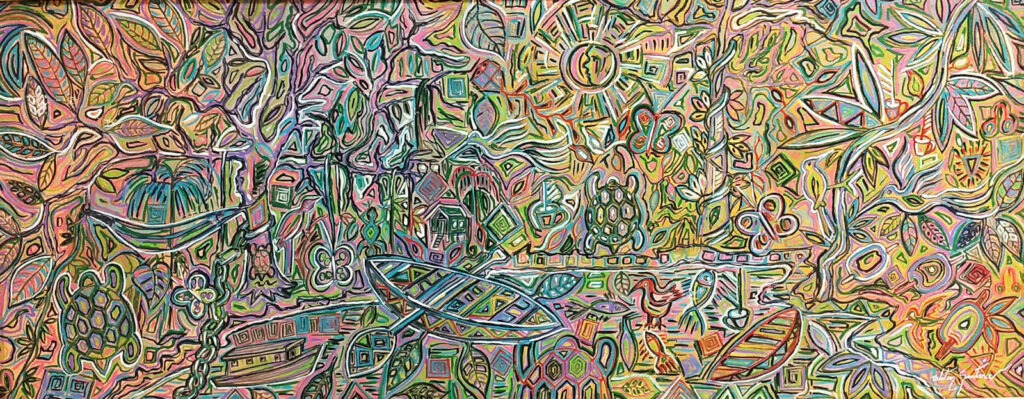The 5th Concertation Meeting of 2023 focused on the challenges and opportunities in land use planning and tenure regularization (OTRF, in Portuguese) in the Amazon. It was held on October 16th in partnership with the Land Governance Institute.
With nearly 100 attendees and mediated by the Concertation’s executive secretaries, Lívia Pagotto and Fernanda Rennó, the event began with the display of video “A vida do solo”, by agroecologist Ana Maria Primavesi, in reference to the World Food Day (10/16). Fernanda Rennó highlighted the link between the topics covered in the video and the meeting´s agenda, particularly the biological complexity of the soil, an issue prior to the organization and use of the land itself:
Fernanda then announced that the visual identity of the Concertation is now inspired by the art of Ueliton Santana, an artist from Acre whose work reflects the intertwining of local culture with the grandeur of the Amazon rainforest:
“The first challenge is to build a land use planning registry for the Amazon, including the different layers of land use types”
(Gabriel Siqueira)
Gabriel Siqueira, president of the Land Governance Institute (IGT) and facilitator of the Concertation´s OTRF WG, was the first guest to speak. He sought to contextualize the level of knowledge available today about the Amazon territory, considering that there is no unified registry today that gathers all information in an organized, transparent and accessible manner. Therefore, the first challenge is to build this database.
As an example, Gabriel displayed a map of the Legal Amazon on which the IGT released data available in public agencies such as Incra (National Institute for Colonization and Agrarian Reform), Funai (National Foundation of Indigenous Peoples) and Sigef (Land Management System). As layers of information were added to the database, it was possible to visualize the overlapping of countless uses and land rights. Likewise, “empty” spaces emerged, which do not correspond to unoccupied areas, but to areas about which there is still no information.
Such data fragility and limitations compromise the understanding and planning of the territory. For him, “knowing what belongs to whom, and where, is a task that precedes land use planning in the Amazon”.
“Environmental regularization cannot be carried out separately from land tenure regularization. One is a prerequisite for the other”
(André Lima)
Next, André Lima, Special Secretary for Deforestation Control and Land Environmental Planning of the Ministry of Environment and Climate Change (MMA), explained the federal government’s efforts on OTRF. He highlighted the Permanent Interministerial Commission for the Prevention and Control of Deforestation and its subcommittee “Amazonia”, the resumption of actions by the Amazon Fund, the development of the fifth stage of the PPCDAm (Action Plan for the Prevention and Control of Deforestation in the Legal Amazon), the creation of program “União com Municípios pela Redução de Desmatamento e Incêndios Florestais” (Union with Municipalities for the Reduction of Deforestation and Forest Fires) and the establishment of the Land Use Planning office.
André argued that, at this time, the government is facing three main challenges: accelerating studies for the allocation of public lands; blocking areas with an already defined destination, but the implementation process of which has not yet been completed; and deciding what to be done with federal areas that do not have a defined destination to prevent them from being used for forest-degrading activities.
“Our aim is to build a national land governance policy“
(Moisés Savian)
In turn, Moisés Savian, Secretary of Land Governance, Tenure and Socio-Environmental Development of the Ministry of Agrarian Development (MDA), recalled that the MDA is being rebuilt and is already showing results, such as the resumption of the agrarian development policy and family farming, agrarian credit and participation in the Technical Chamber for Land Destination and Regularization of Federal Rural Public Lands.
The Ministry states that it is dedicated to working towards a long-term policy for the allocation of public lands, which does not consolidate a speculative perspective or favor those engaged in wrongdoing. For this purpose, a WG was created to study the proposal to build a national land governance policy. In addition to the dimensions of public land registration and management, this policy must include the dimension of agrarian reform, land assessment and taxation, agrarian conflicts and the guarantee of territory for original and traditional peoples.
Savian considers that the land issue is historic and that the current presidential mandate will not be sufficient to resolve it. In this context, the MDA wishes to offer Brazilian society a permanent path to solving the problem, which cannot be susceptible to changes in power.
“Forest protection must be the focus of any discussion on climate emergency”
(José Benatti)
Full professor at the Federal University of Pará (UFPA) and holder of a PhD in Science and Environmental Development, José Benatti brought into discussion the recent attempts to review land rights based on the Marco Temporal (Time Frame) thesis, the climate emergency and rural violence.
For him, this debate must be broadened beyond specific issues, encompassing public policies, instances, instruments and socio-environmental solutions. The search for solutions must involve understanding the complexity of the issue, and proposals must encompass the transversality of public policies.
Benatti explained that Brazil has numerous contradictory legal rules for the planning and allocation of space, which contributes to an increased territorial legal uncertainty. The Amazon, in particular, was occupied based on divergent views, which sometimes consider the territory as a source of resources, and sometimes as a space for coexistence between humans and non-humans, which has led to bloody conflicts.
According to him, the legal-administrative framework we have today cannot respond to the most pressing issue of the 21st century, which is the climate emergency. Considering that several studies show that the most preserved forests are the inhabited forests, one way to fight the climate crisis is precisely to guarantee the territorial rights of indigenous peoples, quilombolas and traditional communities.
The professor argues that Brazilian society must decide “whether the Amazon will be a large farm that produces grains, cattle and minerals or a socio-biodiverse space. There is no middle ground.”
“Demarcated territories are better preserved and help with the climate issue”
(Cristiane Baré)
Last guest to speak, Cristiane Baré, legal advisor for the Coordination of Indigenous Organizations of the Brazilian Amazon (COIAB) and member of the CNJ (National Council of Justice) Working Group “Direitos Indígenas: Acesso à justiça e singularidades processuais” (Indigenous Rights: Access to justice and procedural singularities), addressed the setbacks in the rights of indigenous communities and environmental policies between 2016 and 2022.
She mentioned the current effort to reconstruct these policies, reinforcing her confidence that the indigenous movement will continue to resist pressure and threats and is focused on helping Funai in the demarcation of lands.

